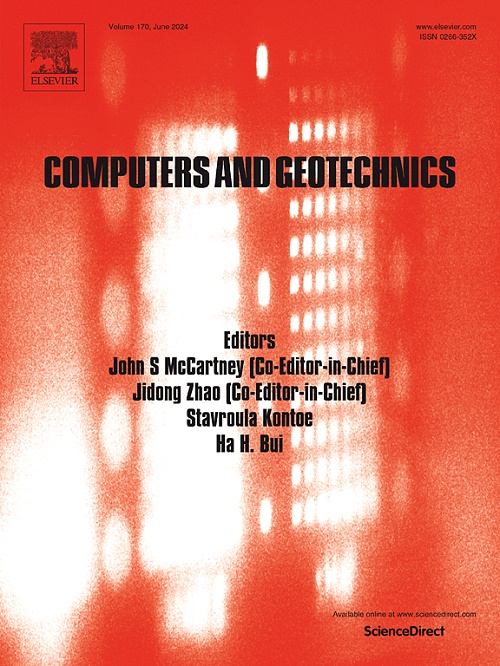α-石英颗粒的纳米尺度接触行为——分子动力学方法
IF 5.3
1区 工程技术
Q1 COMPUTER SCIENCE, INTERDISCIPLINARY APPLICATIONS
引用次数: 0
摘要
岩石表面由不同尺度的凹凸不平组成。岩石多尺度接触变形的精确建模对研究震源力学和裂缝水力特性具有重要意义。为了揭示以往研究中未被关注的岩石颗粒的纳米尺度接触行为,本研究采用分子动力学方法模拟了α-石英颗粒在单颗粒接触下的一系列纳米尺度接触过程。除了研究接触形态和粗糙体尺寸对粗糙体破坏的影响外,我们还将模拟结果与宏观弹性和弹塑性接触模型进行了比较,以评估多尺度的适用性。研究发现,纳米级α-石英颗粒在接触过程中发生破裂,这与传统岩石颗粒的弹性和弹塑性变形假设不一致。粗晶尺寸和接触形态显著影响α-石英粗晶的破坏机制,特别是从塑性为主破坏到断裂破坏的转变。最后,存在多尺度差异,宏观接触模型在预测α-石英颗粒的纳米尺度接触行为方面受到限制。本文的结果强调需要重新评估岩石凹凸变形的假设,并强调考虑岩石凹凸的接触结构和多尺度效应的重要性。本文章由计算机程序翻译,如有差异,请以英文原文为准。
Nanoscale contact behavior of α-quartz asperities — A molecular dynamics approach
Rock surfaces are composed of asperities at various scales. Accurate modeling of the multiscale contact deformation of asperities is of great importance to study the earthquake source mechanics and hydraulic properties of fractures. In this study, to shed light on the nanoscale contact behavior of rock asperities that might not have been paid much attention to in previous studies, we simulated a series of nanoscale contact processes of α-quartz asperities under single-asperity contact employing molecular dynamics method. In addition to the investigation of the influence of contact configuration and asperity size on the asperity failure, we compared the simulation results with macroscopically elastic and elastoplastic contact models to evaluate the multiscale applicability. We observed that fracture occurs in the nanoscale α-quartz asperities during contact process, inconsistent with the traditional assumptions of elastic and elastoplastic deformation of rock asperities. Moreover, the asperity size and contact configuration significantly affect the failure mechanism of α-quartz asperities, specifically the transition from plasticity-dominant failure to fracture damage. Finally, a multiscale disparity exists, where macroscopic contact models are limited to predict the nanoscale contact behavior of α-quartz asperities. The results obtained here underscore the need to re-evaluate the assumptions of rock asperity deformation and emphasize the importance of considering contact configurations and multiscale effects of rock asperities.
求助全文
通过发布文献求助,成功后即可免费获取论文全文。
去求助
来源期刊

Computers and Geotechnics
地学-地球科学综合
CiteScore
9.10
自引率
15.10%
发文量
438
审稿时长
45 days
期刊介绍:
The use of computers is firmly established in geotechnical engineering and continues to grow rapidly in both engineering practice and academe. The development of advanced numerical techniques and constitutive modeling, in conjunction with rapid developments in computer hardware, enables problems to be tackled that were unthinkable even a few years ago. Computers and Geotechnics provides an up-to-date reference for engineers and researchers engaged in computer aided analysis and research in geotechnical engineering. The journal is intended for an expeditious dissemination of advanced computer applications across a broad range of geotechnical topics. Contributions on advances in numerical algorithms, computer implementation of new constitutive models and probabilistic methods are especially encouraged.
 求助内容:
求助内容: 应助结果提醒方式:
应助结果提醒方式:


